The Solidigm P5810 is an enterprise SSD that incorporates 144-layer SLC 3D NAND and Client Storage Abstraction Layer (CSAL) to deliver an extreme endurance drive that’s rated for up to 65 drive writes per day (DWPD). The P5810 is available in a capacity of 800GB (with a 1.6TB model to be available shortly) and is designed to meet the evolving needs of data centers and HPC applications.
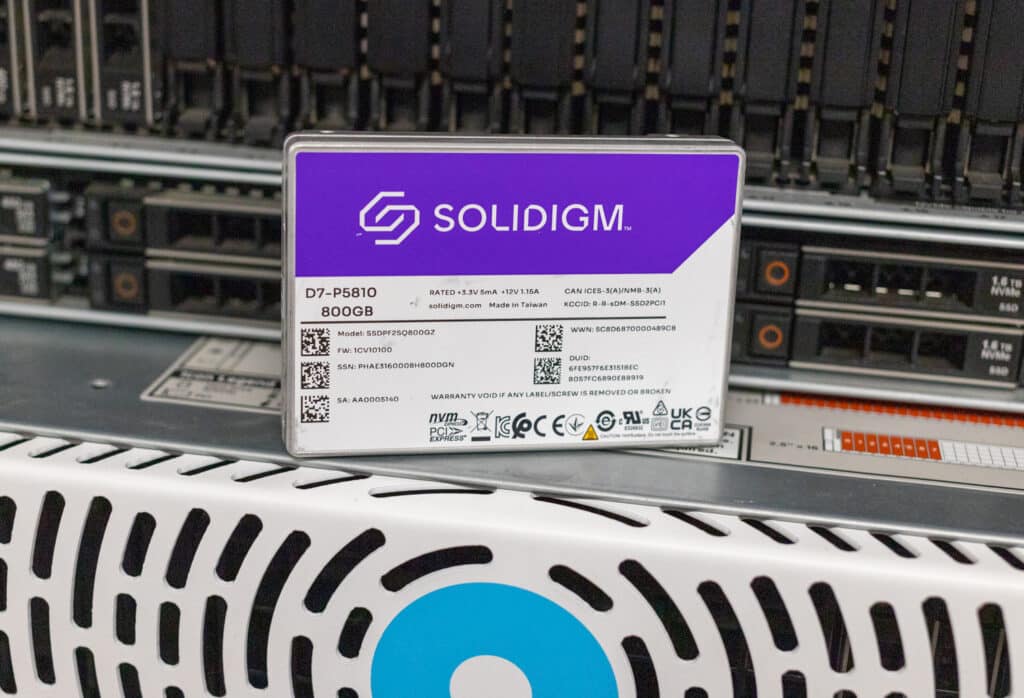
Performance-wise, the D7-P5810 offers up to 6,400MB/s and 4,000MB/s in sequential read and write bandwidth, respectively, while random performance is quoted at 865,000 IOPS read and 495,000 IOPS write. The drive also features an impressive endurance rating of up to 65 drive writes per day (DWPD) for sequential and up to 50 DWPD for random workloads. This underscores its suitability for extreme write-intensity tasks, ensuring longevity and consistent performance in environments where data is frequently updated or replaced.
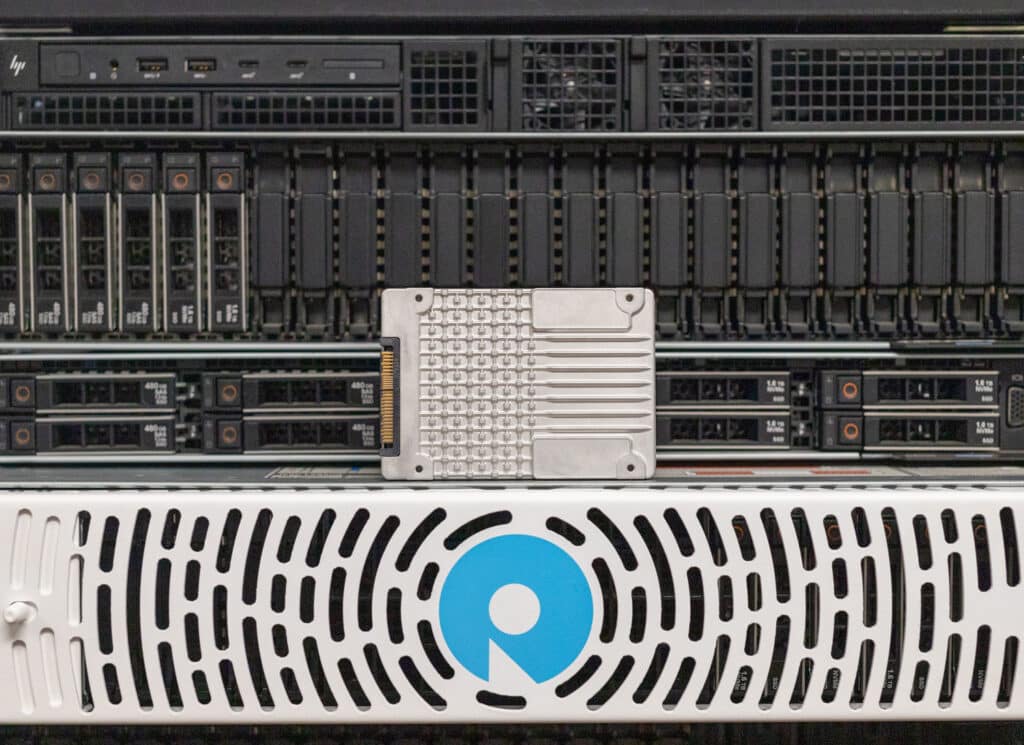
The Solidigm P5810 is tailored for scenarios that not only demand the longevity provided by high drive writes per day but also require speed and responsiveness. Many storage architectures can benefit from high-endurance drives like this. Typically we’d think about drives like this being used in a write cache tier, like the vSAN OSA environment or VAST Data for instance. While Optane has been the leader in this category, Intel has decided to retire that product, so the industry is a little light in high endurance choices, the KIOXIA FL6 appears to be one of the last SSDs standing in the classic storage-class memory (SCM) category.
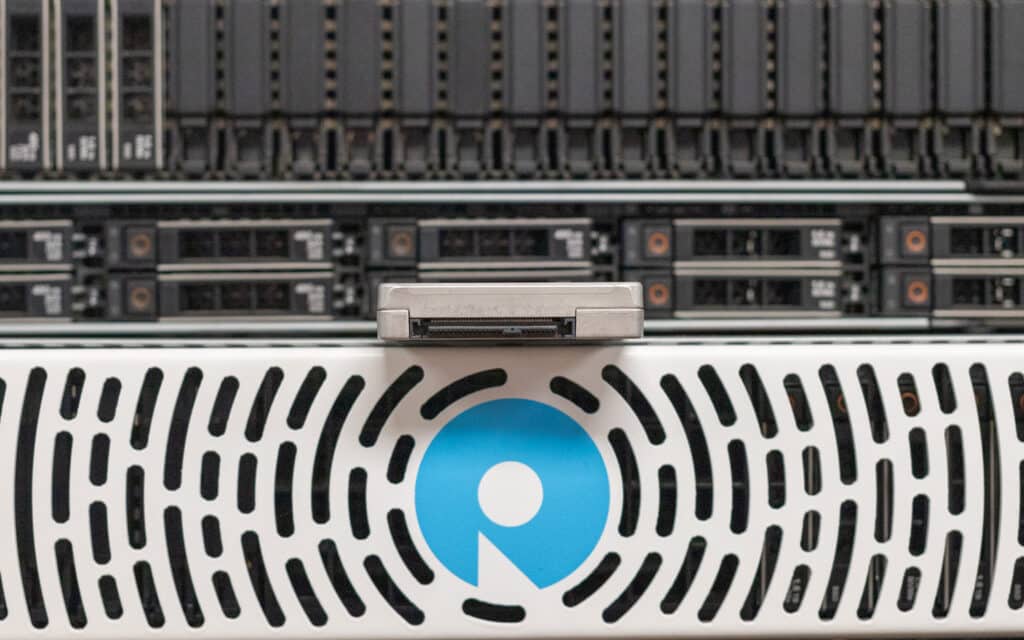
While SCM generally tries to offer extreme endurance and performance in one package, this comes at a cost, these drives are very expensive per TB. The new breed of low-capacity, high-endurance drives like the P5810 that are coming to market now are really designed to offer the endurance high write environments need, with a traditional NAND package that doesn’t throw the cost equation off balance. So in this category, Solidigm is banking that the industry is willing to pay for endurance rather than extremely low latency.
Solidigm D7-P5810 Specifications
| Specification | Detail |
| Capacity | 800 GB |
| Form Factor | U.2 15mm |
| Interface | PCIe 4.0 x4, NVMe |
| Weight | 153g |
| Lithography Type | 144L SLC 3D NAND |
| Use Conditions | Server/Enterprise |
| Performance – Random Read (100% Span) | 865,000 IOPS (4K, QD256) |
| Performance – Random Write (100% Span) | 495,000 IOPS (4K, QD256) |
| Power – Active | 12W |
| Power – Idle | 5W |
| Latency – Random Read (typ.) | 53μs |
| Latency – Random Write (typ.) | 15μs |
| Latency – Sequential Read (typ.) | 10μs |
| Latency – Sequential Write (typ.) | 13μs |
| Warranty Period | 5 years |
| Endurance Rating (Lifetime Writes) | 50 DWPD/73 PBW |
| Mean Time Between Failures (MTBF) | |
| Vibration – Operating | 2.17 GRMS (5 – 700 Hz) Max |
| Vibration – Non-Operating | 3.13 GRMS (5 – 800 Hz) Max |
| Shock (Operating and Non-Operating) | 1,000 G (Max) at 0.5 msec |
| Operating Temperature Range | 0 – 70°C |
Solidigm P5430 Performance
Testbed
Our PCIe Gen4 Enterprise SSD reviews leverage a Lenovo ThinkSystem SR635 for application tests and synthetic benchmarks. The ThinkSystem SR635 is a well-equipped single-CPU AMD platform, offering CPU power well over what’s needed to stress high-performance local storage. Synthetic tests don’t require a lot of CPU resources but still leverage the same Lenovo platform. In both cases, the intent is to showcase local storage in the best light possible that aligns with storage vendor maximum drive specs.
PCIe Gen4 Synthetic and Application Platform (Lenovo ThinkSystem SR635)
- 1 x AMD 7742 (2.25GHz x 64 Cores)
- 8 x 64GB DDR4-3200MHz ECC DRAM
- CentOS 7.7 1908
- ESXi 6.7u3
VDBench Workload Analysis
When it comes to benchmarking storage devices, application testing is best, and synthetic testing comes in second place. While not a perfect representation of actual workloads, synthetic tests help baseline storage devices with a repeatability factor that makes it easy to make apples-to-apples comparisons between competing solutions. These workloads offer a range of testing profiles ranging from “four corners” tests and common database transfer size tests to trace captures from different VDI environments.
All of these tests leverage the common vdBench workload generator, with a scripting engine to automate and capture results over a large compute testing cluster. This allows us to repeat the same workloads across a wide range of storage devices, including flash arrays and individual storage devices. Our testing process for these benchmarks fills the entire drive surface with data and then partitions a drive section equal to 25% of the drive capacity to simulate how the drive might respond to application workloads. This differs from full entropy tests, which use 100 percent of the drive and take them into a steady state. As a result, these figures will reflect higher-sustained write speeds.
Profiles:
- 4K Random Read: 100% Read, 128 threads, 0-120% iorate
- 4K Random Write: 100% Write, 128 threads, 0-120% iorate
- 64K Sequential Read: 100% Read, 32 threads, 0-120% iorate
- 64K Sequential Write: 100% Write, 16 threads, 0-120% iorate
- Synthetic Database: SQL and Oracle
- VDI Full Clone and Linked Clone Traces
Our review pits the P5810 against the retired Intel Optane P5800X to assess Solidigm’s NAND-based solution’s endurance and performance when compared to Optane technology. While nothing can really compare to the Intel P5800X at the moment (even though it was released back in 2021), the P5810 aims to meet the high-endurance rates with up to 65 DWPD for sequential workloads and seeks to offer a cost-effective alternative at a higher capacity point than the Optane drive. We are also including the Solidigm P5520 among the comparables, which serves as a baseline within the brand’s range.
In our first VDBench Workload Analysis, random 4K read, the Solidigm P5810 had a peak performance of just 920K IOPS at a pretty steep latency of 553.6µs. This placed it behind the other drives.
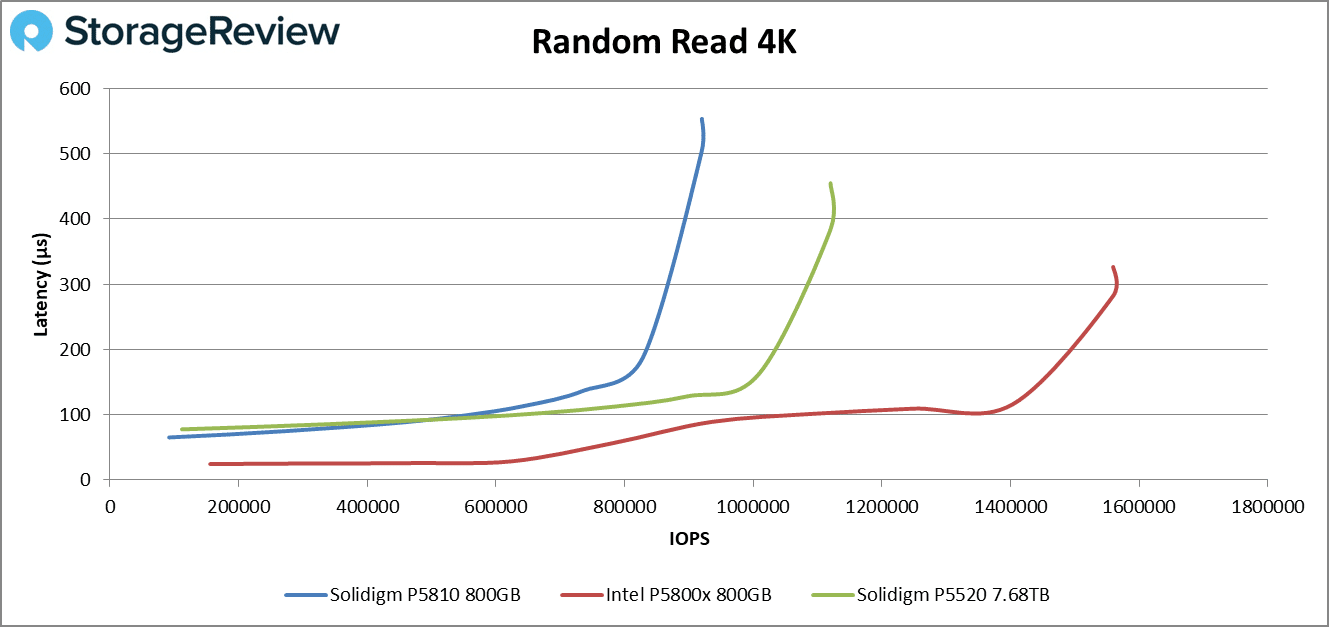
In 4K random write, the Solidigm P5810 had a peak of 664K IOPS with a latency of 762µs, placing it well behind the Intel Optane drive but better than the P5520.

Switching over to 64k sequential workloads, the Solidigm P5810 fell back a bit in reads, peaking at 5.91GB/s (94K IOPS) with a latency of 671.6µs.
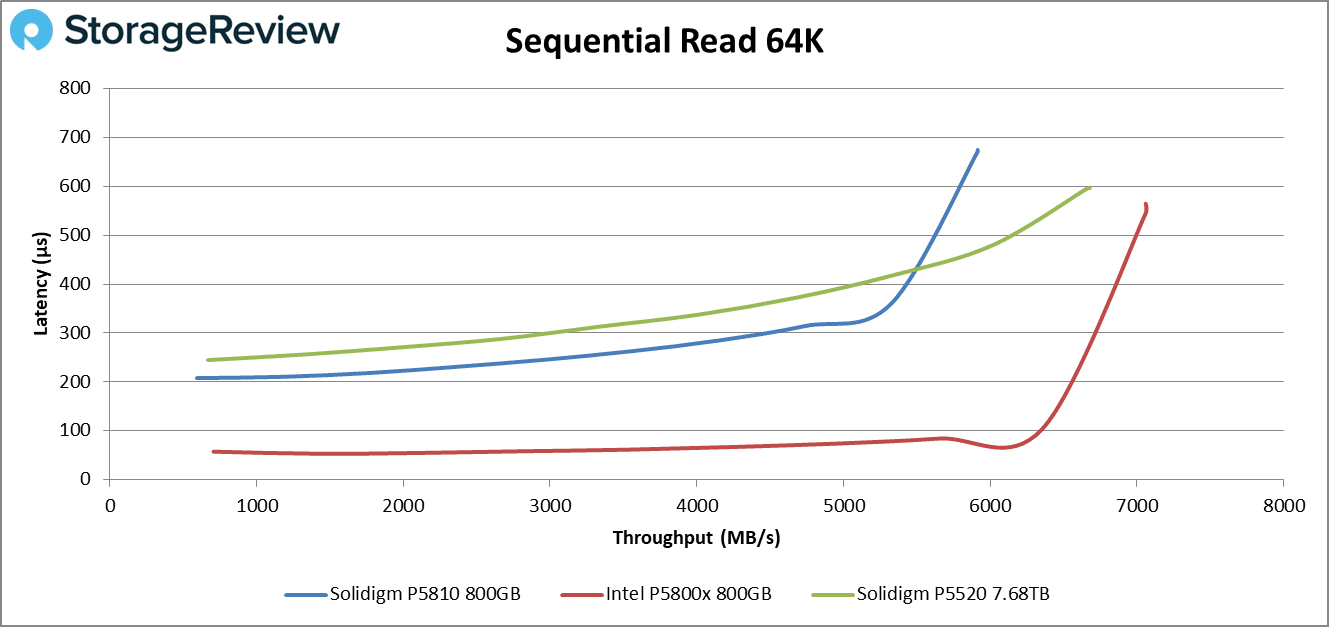
In sequential writes, the Solidigm P5810 was right in the middle of the pack, peaking at 3.79GB/s write (61K IOPS) at 1,045µs in latency.
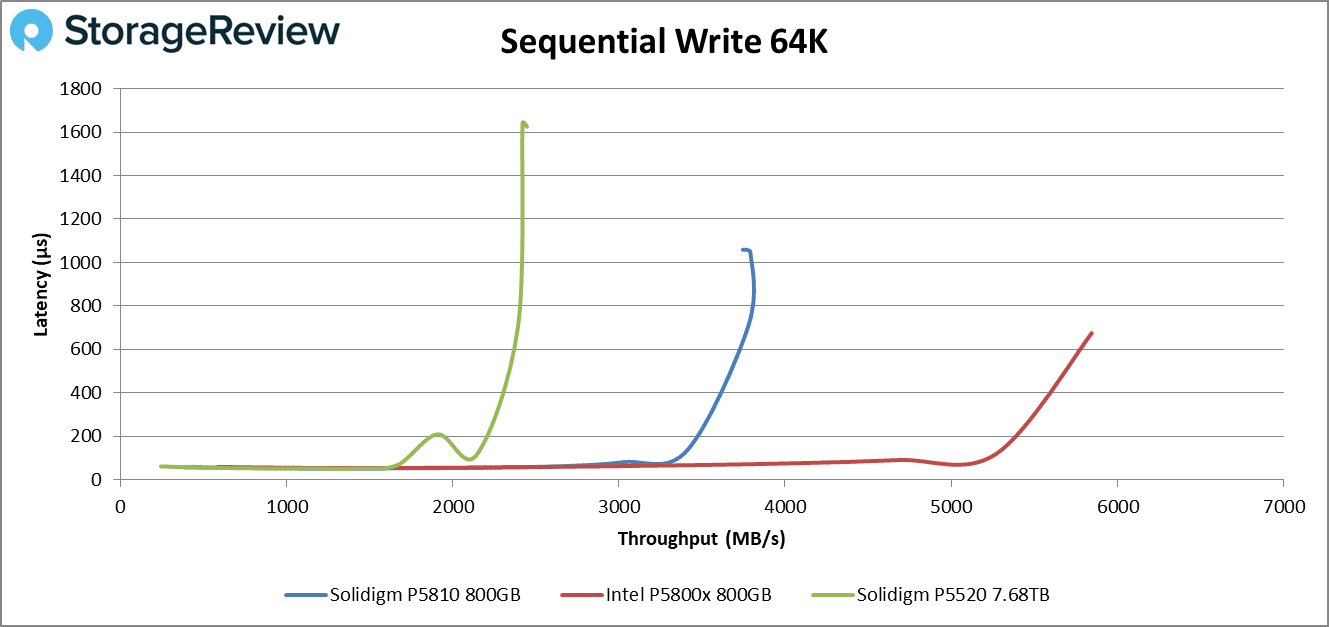
Our next set of tests is our SQL workloads: SQL, SQL 90-10, and SQL 80-20. Starting with SQL, the Solidigm P5810 posted a peak performance of 374K IOPS with a latency of 84.5µs.
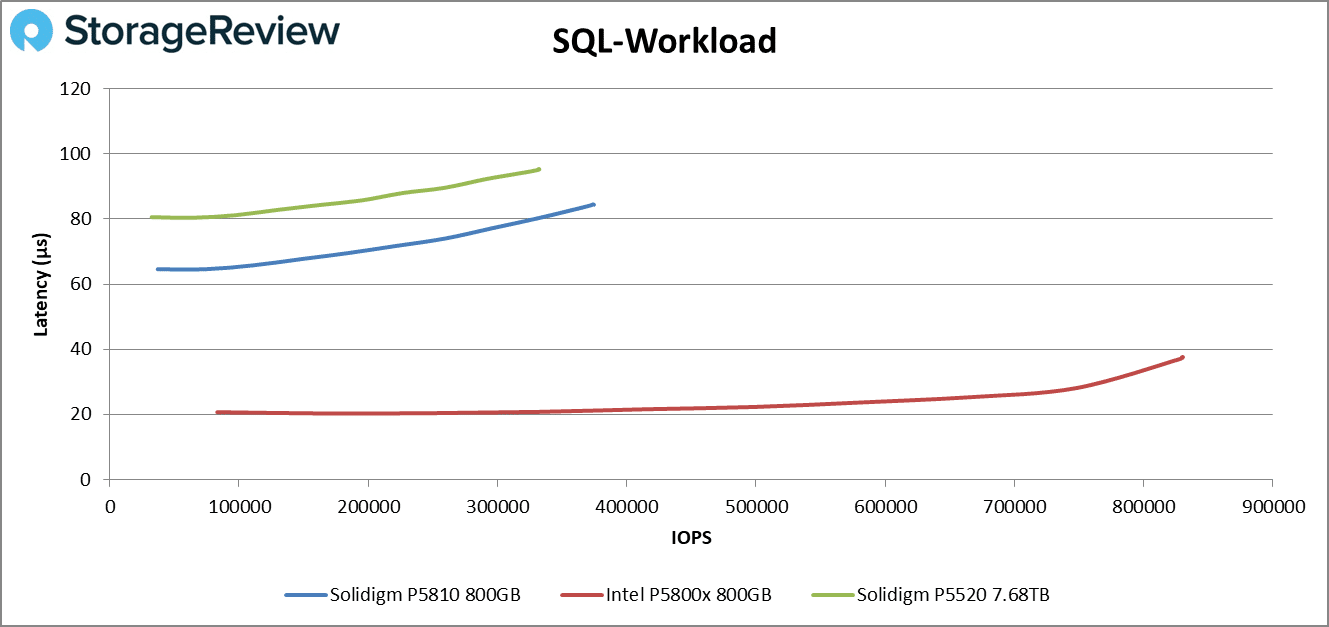
In SQL 90-10, the P5810 showed a peak performance of 370K with a latency of 85µs.

With SQL 80-20, the Solidigm P5810 had near-identical performance, peaking at 369K IOPS at a latency of 85µs.

Next up are our Oracle workloads: Oracle, Oracle 90-10, and Oracle 80-20. As with the SQL benchmarks, the Solidigm P5810 continued to take second place with decent numbers (with the Optane drive far beyond the two Solidigm drives). Starting with the general Oracle workload, the P5810 drive had a peak performance of 365K IOPS at 94.9µs.

Looking at Oracle 90-10, the Solidigm P5810 posted a peak performance of 287K IOPS at 75.7µs.
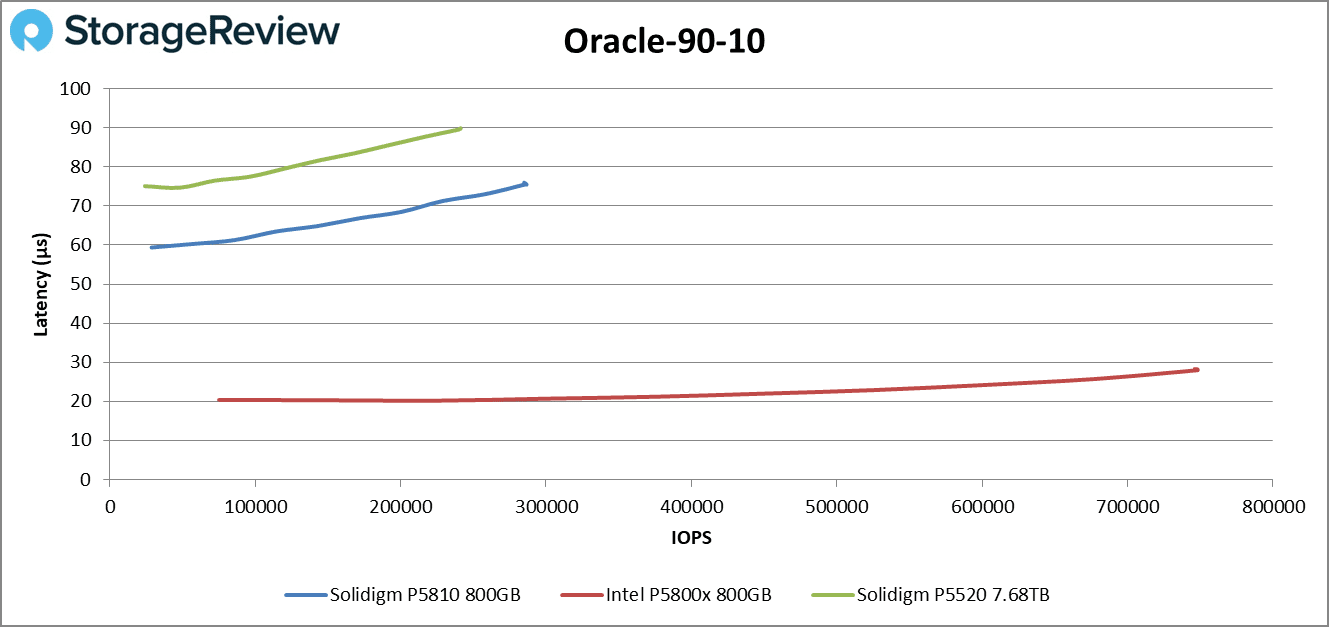
Next up is Oracle 80-20, where the P5810 showed a near-identical peak of 288K IOPS at 74.5µs.

Next, we switched to our VDI clone test, Full and Linked. For VDI Full Clone (FC) Boot, it peaked at 229K IOPS with a latency of 153.2µs being edged out by the P5520 at the very end of the test.

During VDI FC Initial Login, the P5810 peaked at a solid 177K IOPS with a latency of 165µs.

With VDI FC Monday Login, the P5810 posted 129K IOPS at a latency of 121.3µs, showing a noticeable gain over the other Solidigm drive.
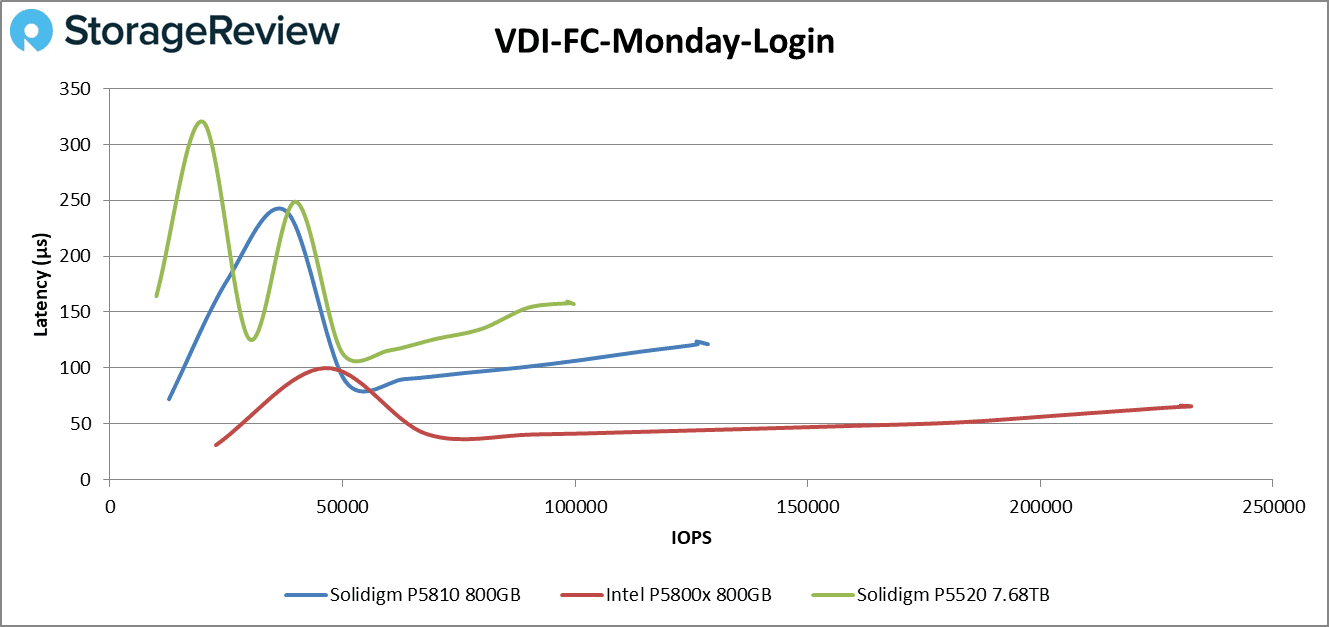
For VDI Linked Clone (LC) Boot, the P5810 showed a peak of 101K IOPS with 157µs.
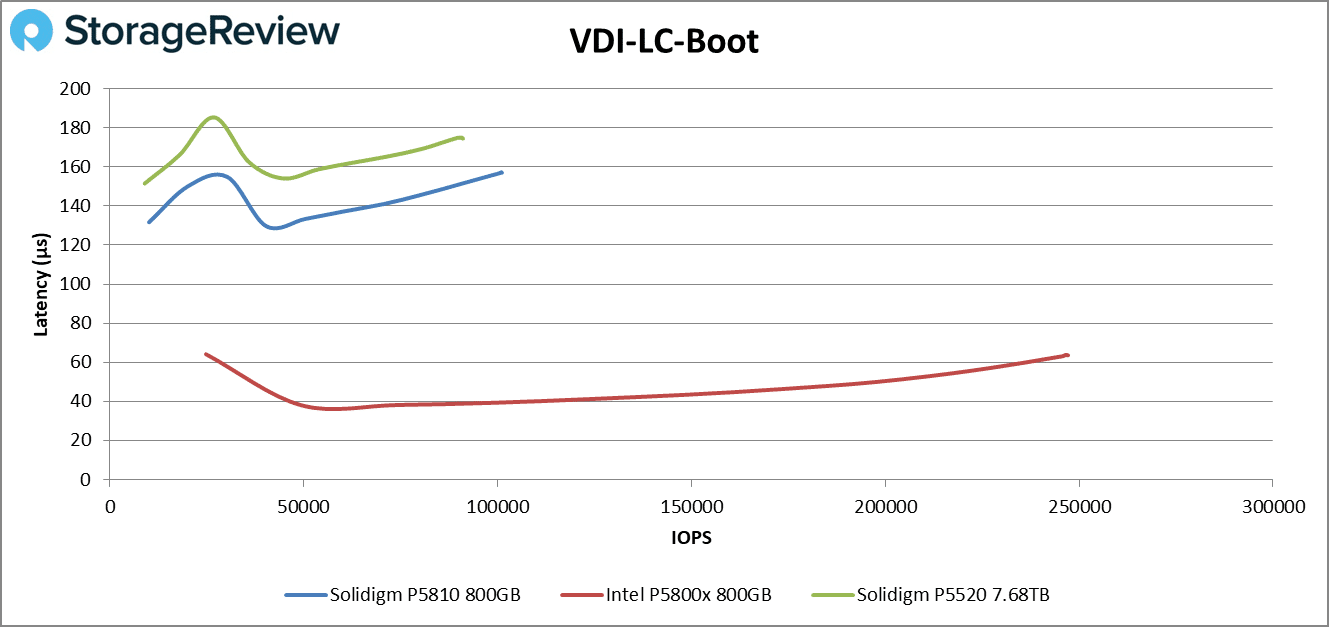
In VDI LC Initial Login, the Solidigm P5810 showed some instability, where it peaked at 69K IOPS at 112.2µs, taking a noticeable spike in performance when approaching 25K IOPS.

For VDI LC Monday Login, the P5810 came in the middle of the pack, peaking at 98K IOPS with a latency of 158.6µs.
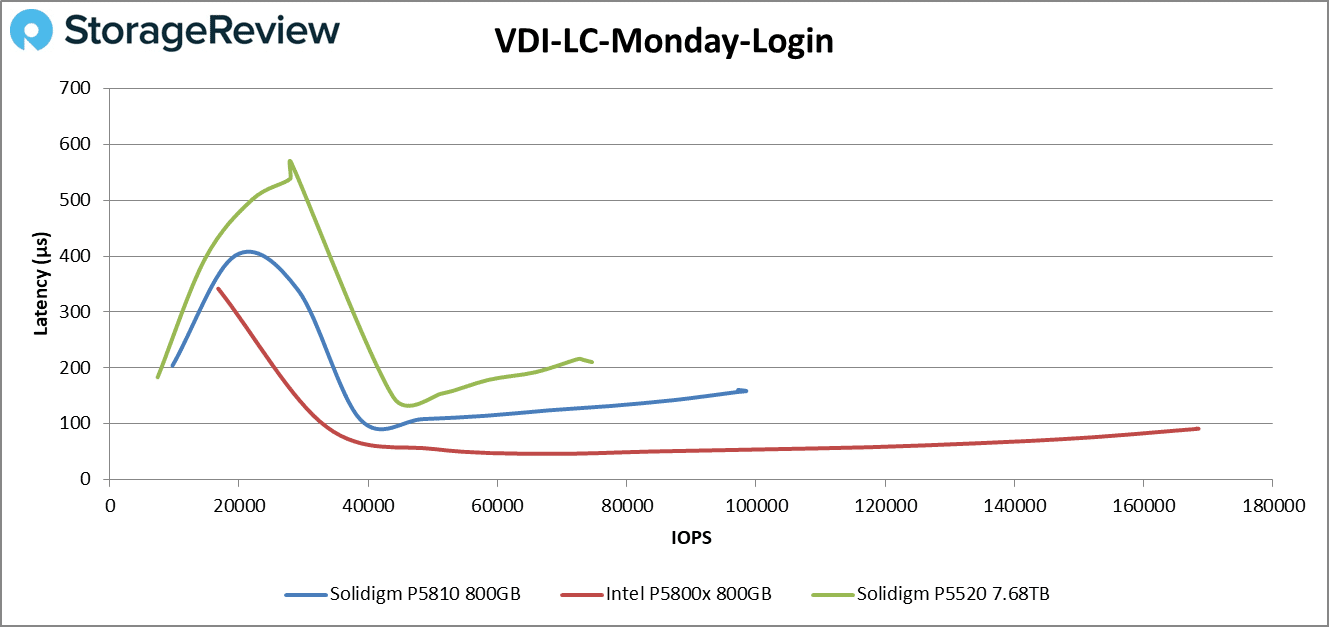
Conclusion
The Solidigm P5810 stands out as a noteworthy addition to the company’s enterprise SSD portfolio. The drive’s integration of 144-layer SLC 3D NAND technology and CSAL reflects a deliberate focus on optimizing write processes, which is crucial for the demanding workloads of data centers and high-performance computing applications.
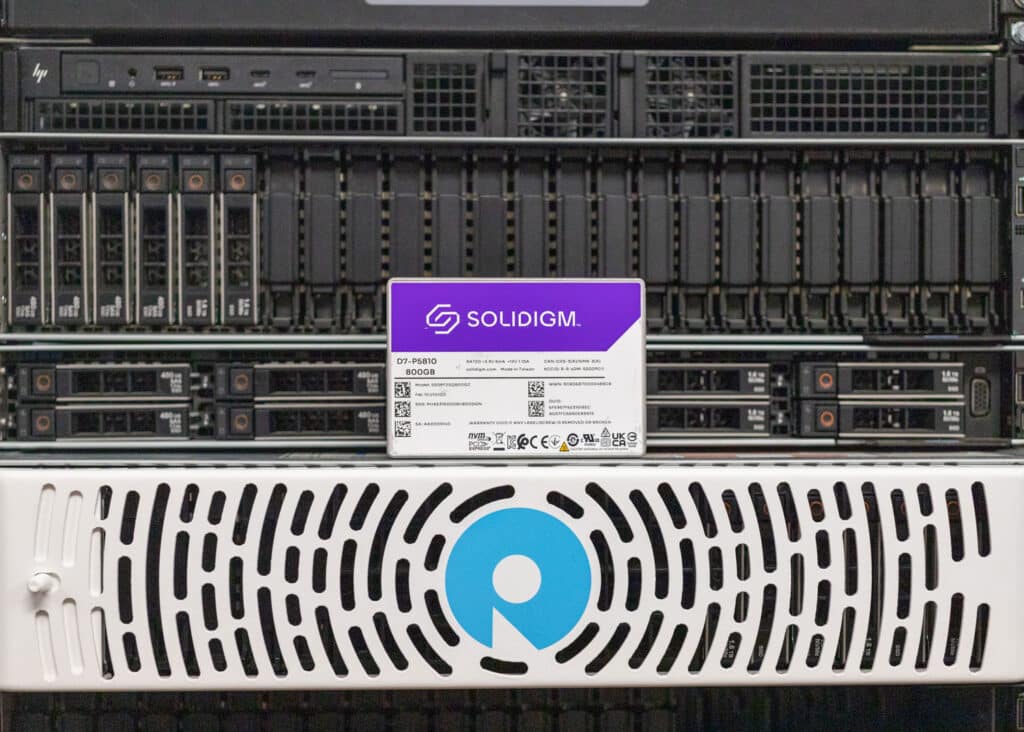
As we look at the performance results, the charts require a little bit of nuance to classify the performance. Emphasis should be placed on heavy write and mixed workload performance, using this class of drive for read-heavy applications makes little sense. With that framework laid out, we do see that the P5810 outpaces the mainstream P5520 drive in writes. What can’t be ignored though is the SCM-class Optane drive still holds a huge overall lead.
As we’ve said, however, the Optane drive line has been retired and there seems no appetite from the industry to see it return. Intel couldn’t sell the Optane business and clearly, customer demand just wasn’t there. According to many we’ve talked to, this is largely due to the cost/TB of those drives. It’s also worth noting that high-endurance (3DWPD) mainstream TLC drives perform very well at this point, closing some of the performance gap Optane had. So it appears the question is more about endurance for these high-write environments. Optane was at 100 DWPD, and the P5810 comes in with up to 65 DWPD, depending on workload. Solidigm feels this is sufficient to meet the needs of a number of use cases; that remains to be seen.
The model that is the most exciting to Solidigm, would be any architecture that could leverage the P5810, sitting in front of their mega-capacity QLC drives. The QLC drives deliver excellent read performance but can pay a price when it comes to writes. So a handful of P5810s in front of a chassis full of P5336s could be something. We look forward to exploring use cases like this more in the future, for now, we just have this single review unit. With the promise of a 1.6TB version on the horizon, Solidigm is aligning its broad SSD offerings with the future trajectory of varied enterprise storage needs, ensuring a broad portfolio of solutions.




 Amazon
Amazon